Menu
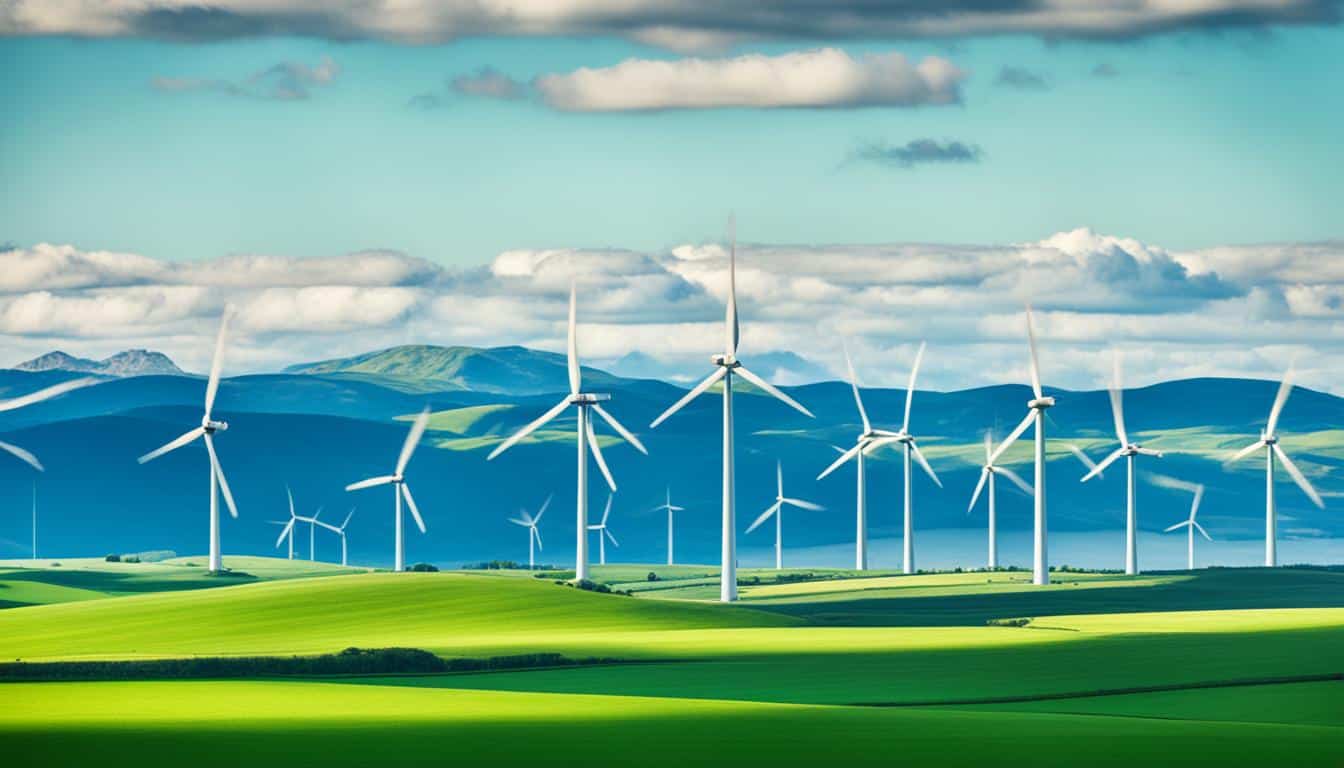
Did you know that by 2022, renewable energy made up almost 21% of U.S. electricity? This shows a big jump in the use of clean energy. It proves the U.S. is working hard towards a green future. The info comes from the US Federal Energy Regulatory Commission (FERC). They updated us on energy numbers in August 2023 and again on November 15, 2023.
The U.S. Energy Information Administration (EIA) also shared details in their report from October 2023. They looked at energy production for all uses. So, we got a full picture of how renewables are making a difference.
Big laws like the Inflation Reduction Act and the Bipartisan Infrastructure Law are helping a lot. They give a push to the clean energy industry. The International Renewable Energy Agency (IRENA) talks often about the world’s shift to clean energy. Their discussions cover a wide range of topics, highlighting the journey towards more sustainable energy.
Renewable power systems are seeing amazing progress, mainly in the U.S. Recent research from the National Renewable Energy Laboratory praised laws like the Inflation Reduction Act. These laws have helped the U.S. power system a lot. But, the sector also faces big challenges. These include higher interest rates and problems in getting parts.
In 2023, clean power hit a new high. The U.S. added 31 gigawatts (GW) of solar energy, a 55% jump from 2022. Solar power now makes up half of all new energy. Battery storage installations also did well. By the third quarter of 2023, they had already passed 2022’s total, with a plan to double by 2024.
Yet, renewable energy isn’t without worries. There’s a big problem with getting parts, seen in how long it takes to get transformers – up to 150 weeks. This slow delivery is a major problem for getting more renewable energy online. Also, the rise in interest rates is making renewable energy projects more expensive.
Now let’s dive into the numbers on renewable energy’s progress and barriers:
| Metric | 2023 Data | Comparison to Previous Year |
|---|---|---|
| Installed Solar Capacity | 31 GW | +55% |
| New Utility-Scale Generating Capacity (Solar) | 50% | Up to Q3, 2023 |
| Battery Storage Installations | Exceeding 2022 | Projected to double by 2024 |
| Wind Energy Growth | 8 GW | Total of 147 GW by Q3, 2023 |
| Record EV Sales | 1.2 million | 7.6% of total vehicle sales |
| Corporate Clean Energy Purchases | 6 GW (H1) | 17 GW (2022) |
In 2023, more than three-quarters of new energy came from renewables, paired with energy storage. This same year saw an electric vehicle (EV) sales record. 1.2 million EVs were sold in the U.S. – that’s 7.6% of all vehicles, up from 5.9% in 2022.
The U.S. also shone in planning for clean energy manufacturing, with a record $421 billion in new projects. But, not all was smooth. Corporate clean energy buying was down in early 2023, compared to 2022. This shows different levels of business interest in green energy.
It’s important to know the laws that affect green energy projects. Laws like the Inflation Reduction Act and the Bipartisan Infrastructure Law have changed things. The National Renewable Energy Laboratory (NREL) detailed this in its studies. They show how these laws have changed the planning and building of green energy projects nationwide.
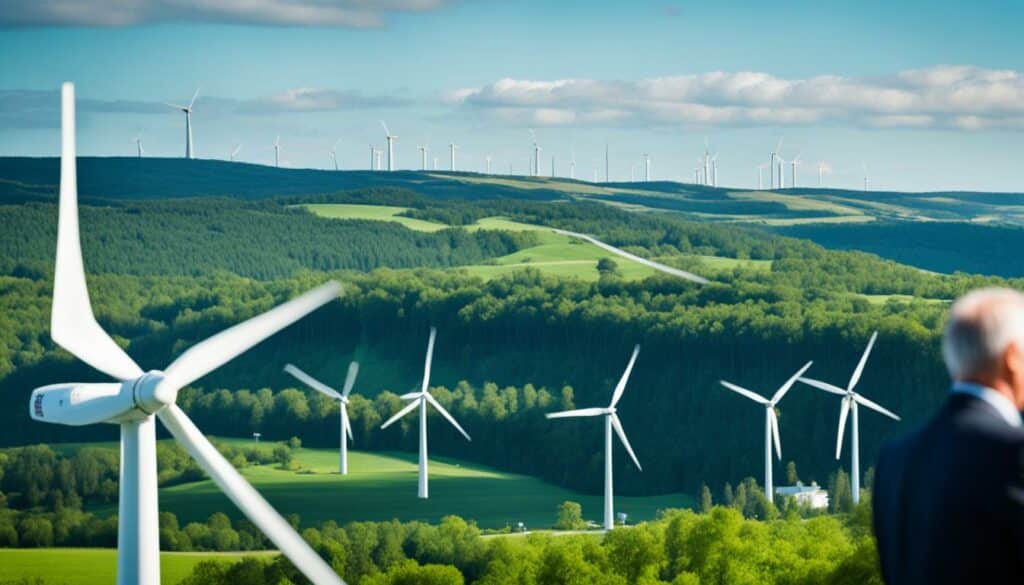
The Inflation Reduction Act offers big tax breaks and grants to help green energy grow. Take Texas, for instance. Senate Bill 2627 there offers 3% loans to build gas-based power plants. It also gives bonuses for adding new plants to the electric grid by June 2029. Besides, more money is going towards making the electricity system better.
The Bipartisan Infrastructure Law is a big step forward for green energy. In Texas, House Bill 1500 changes how electric companies make money. It sets a $1 billion limit on a key financial tool. Moreover, it adds a new way to pay power makers for supporting the electric grid. So, the Public Utility Commission of Texas now has more money to work with each year.
This law also adds $5 billion to help with loans and grants over two years. However, it means everyone on the ERCOT grid in Texas may pay more for electricity. This is because of these new ways to handle money. Not all the ideas, like quick-building gas plants and tougher rules for wind and solar, became laws. Talks from groups supporting the public and industry players made a big difference in what the laws ended up being.
| Legislation | Key Provisions | Impacts |
|---|---|---|
| Senate Bill 2627 | Low-interest loans, grid connection bonuses, infrastructure grants | Support for new gas-fueled power plants, modernising infrastructure |
| House Bill 1500 | Earnings reform, $1 billion financial cap, ancillary service rewards | Changes in electricity market earnings, grid support incentives |
| Inflation Reduction Act | Federal tax credits, grants | Increased financial support for renewable energy companies |
| Bipartisan Infrastructure Law | Comprehensive infrastructure funding | Enhanced support for diverse energy infrastructure projects |
It’s not yet clear how these new laws will affect what Texans pay for electricity. As things move forward, we’ll see the real effects. Texas is working hard to meet its green energy goals.
We’re seeing big changes in how we get our energy. New technologies in renewable power are making a big difference. The cost of clean energy tech is going down. This makes big renewable power plants more effective and easier to build.
The price drop in clean energy is changing how we make energy from renewable sources. The US saw 31 gigawatts of new solar energy in 2023. That’s a lot of new solar power. Solar energy is growing fast, with most of this world growth coming from solar panels on roofs and in fields.
China is a key player in making new solar technology. It made about 95% of solar panels in 2022. This shows how important China is for making solar energy happen globally.
Wind power is also growing fast, especially in China. In 2023, wind power in China grew by 66%. This shows that wind energy is becoming more and more popular. But some places, like the US and UK, had to cancel big wind projects. This makes us think about how to best use wind energy in these areas.
To make these new technologies work well, we need smart plans. How we build and use renewable energy has to be thought out very carefully. Good planning is a big part of making renewable energy successful.
In the next five years, the amount of solar and wind power is expected to grow a lot. Brazil and India will use a lot of biofuels. Around the world, more electricity will come from renewable sources than coal by 2025. These facts show how we are shifting to cleaner energy.
Hydropower is different from other renewable sources. It made more electricity than any other in 2022. But, the new additions of hydropower are expected to go down gradually. This tells us we need different ways to keep up the good work with renewable energy.
With new tech and smart plans, the future of renewable energy looks bright. We can expect a green and sustainable energy world in the years to come.
| Year | Technology | Capacity (GW) | Notable Trends |
|---|---|---|---|
| 2022 | Solar PV | China: 95% Manufacturing | Strong manufacturing growth |
| 2023 | Solar PV | Global: 31 GW | Record installations in the US |
| 2023 | Wind Energy | China: 66% Increase | Significant capacity surge |
| 2023 | Offshore Wind | US/UK: 15 GW | Project cancellations |
Green energy networks are key to making our power safer and more sustainable. They supplied 12% of the US’s energy in 2020. This shows we’re using more eco-friendly sources, which helps cut carbon emissions.
This change is good for jobs too. Over 3 million new jobs came from green energy in the US in 2022. Moving towards zero net carbon could add another million jobs. So, choosing green instead of fossil fuels helps the economy by creating more work.
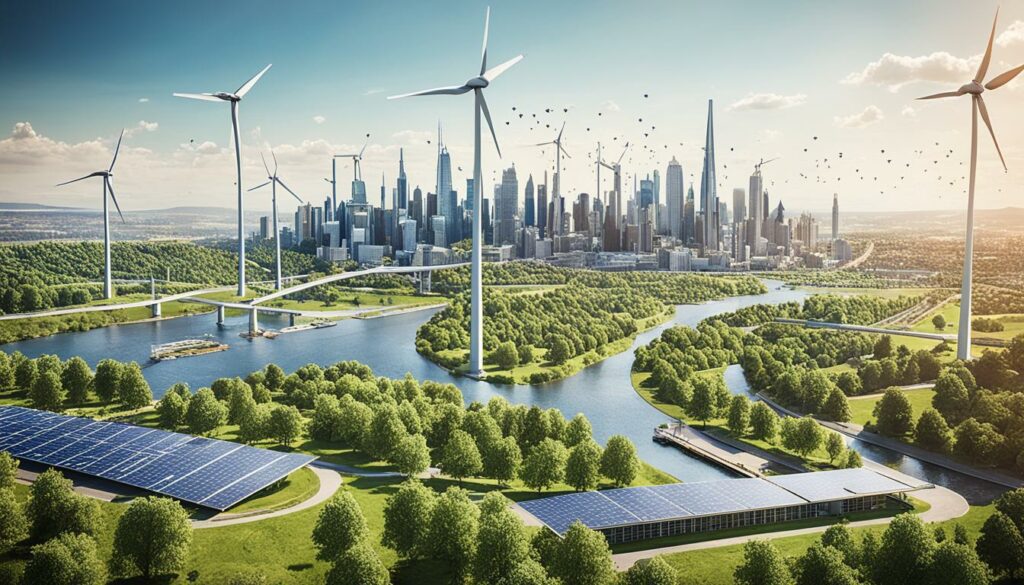
Using just 35% wind and solar power for US electricity could cut carbon a lot. It might drop emissions by up to 45%. Plus, it could lessen air pollution, which might save thousands of lives from illnesses caused by dirty air.
Upgrading power grids is also vital for the transition to clean energy. It helps keep the grid running smoothly. Good energy planning can speed up investment and make the change happen faster, just as Africa is working on with help from IRENA. It shows how important green energy networks really are.
| Energy Statistic | Value |
|---|---|
| US energy consumption from renewables (2020) | 12% |
| New jobs in renewable and green energy sectors (2022) | 3 million+ |
| Potential job increase by transitioning to a net-zero economy | 1 million |
| Reduction in carbon emissions by generating 35% of electricity with wind and solar | Up to 45% | Year U.S. targets 100% clean electricity | 2035 |
| Estimated increase in renewable energy consumption (through 2050) | Continual rise |
The US aims for 100% clean power by 2035, linking with global goals. These goals aim to rely mostly on renewables by 2050 to cut emissions to zero. Achieving this target highlights our work towards more sustainable energy.
Big steps in eco-friendly power infrastructure show a strong mix of community efforts and large investments. These moves are key for promoting clean energy worldwide.
Communities are vital in promoting green energy. By 2030, we expect 60% of energy to be from renewable sources. Local projects help with energy independence, create jobs, and save money on energy.
In places like Latin America and the Caribbean, putting 1.3% of the local GDP towards renewables can make 7 million new green jobs in 10 years. These efforts connect eco-friendly power and local community well.
Both public and private money are significantly growing renewable energy. Projects like the NEVI show how they join forces for a cleaner future. The World Bank’s $10 billion in energy projects and the rise of wind and solar over fossil fuels prove the commitment.
The teamwork of public and private actors is crucial for change. Tackling electricity issues in areas like sub-Saharan Africa, where many still lack it, shows the urgent need for shared investment in green power.
Renewable energy projects often face delays, a big worry for builders around the globe. The main culprit is slow supply chains. These issues slow our movement towards producing energy in a more sustainable way to meet global needs.
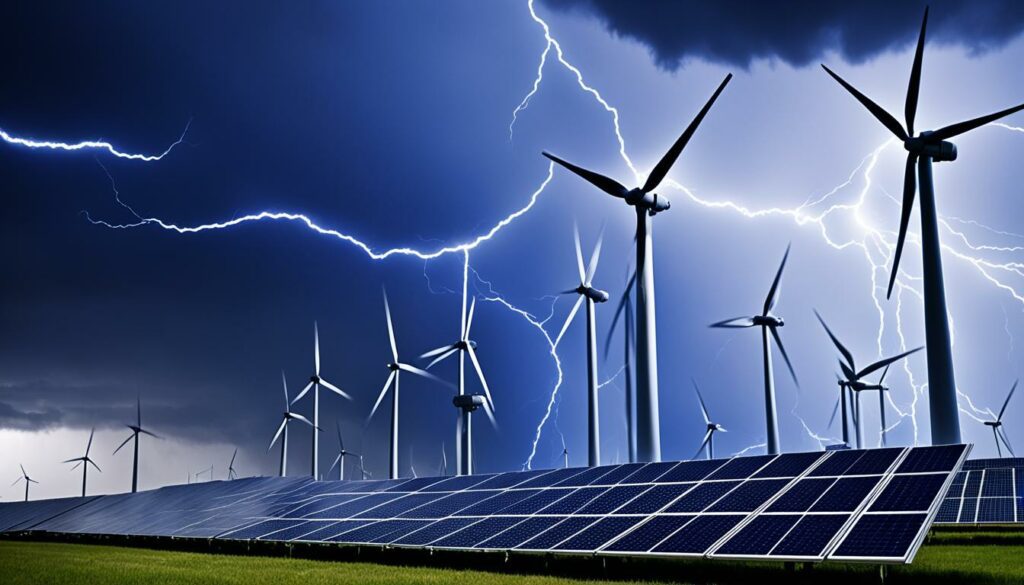
Rising costs and the need to talk over power deals make building renewable energy harder. The company Solaris hopes to see more solar power added, about 6000 to 7000 MW every year from 2023 to 2027. But challenges like these could put the brakes on such growth.
Supply chain problems are only part of the issue. Some countries have delayed auctions where they sell electricity, pushing back projects more. Also, old energy systems make it tough to use new renewable tech like solar and wind power.
But, there’s some good news. Using big batteries to store excess energy can help. A company called Prismecs put a 7 MW battery system in place, making energy use more stable. Projects like these show there’s hope for solving current issues.
However, challenges from the market continue. Wind energy might get cheaper, but other money and system issues keep coming up. Compared to using fossil fuels, it’s still more costly to install renewable energy sources, a big problem.
The way policies are set also matters a lot. Lots of future wind and solar projects rely on government auctions or help that hasn’t been confirmed yet. This waiting game slows down the whole process. But, the microgrid market’s expected growth to over USD 168.64 billion by 2032 gives us hope. Innovative energy solutions may lead the way.
So, while renewable energy has great potential, it faces many tough hurdles. Solutions lie in fixing the supply chain, updating old systems, and making strong, clear policies. These steps are crucial to making a more sustainable energy future.
The move to clean energy infrastructure brings big economic rewards. Switching to sources like wind, solar, and others has cut costs a lot. This makes green energy easier and cheaper to use. Plus, these types of energy produce very little pollution, helping our world and saving money.
Choosing renewable energy is paying off. For example, the money put into these technologies at the start leads to steady prices. This is unlike the up-and-down costs of fossil fuels. By aiming for 25% of power from renewables by 2025, we could cut CO2 a lot. This is like not using 70 coal plants. Lower costs make clean energy very attractive, helping both folks at home and companies.
Clean energy is also creating a lot of jobs. In 2016, the U.S. wind sector had over 100,000 jobs, while solar had over 260,000. By 2025, over 200,000 new jobs could be out there. This means more money for people and landowners, and helps areas that depended on coal and oil.
| Energy Source | CO2 Emissions (pounds CO2E/kWh) |
|---|---|
| Wind | 0.02 to 0.04 |
| Solar | 0.07 to 0.2 |
| Geothermal | 0.1 to 0.2 |
| Hydroelectric | 0.1 to 0.5 |
Together, these benefits show the power of clean energy. It cuts costs and adds lots of jobs. As time goes on, clean energy becomes even more key to a strong, green future.
The year 2023 stands out for its big step towards sustainable energy. Stats from the Deloitte renewable energy growth report and Berkeley Lab show very positive signs in large solar projects. Bloomberg New Energy Finance adds that the cost to make clean energy is going down thanks to lower material costs and interest rates.
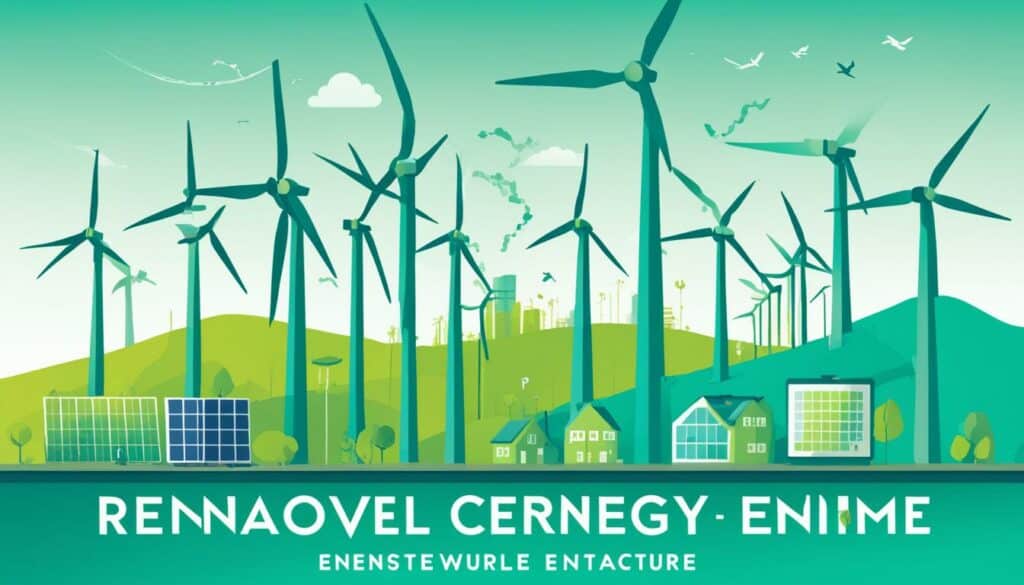
In March 2023, the National Renewable Energy Laboratory looked at new laws affecting energy in the U.S. They found these laws made solar and wind power grow more. The International Energy Agency (IEA) expects the cost of solar panels and wind turbine equipment to fall, helping more renewable energy grow.
Let’s look closer at the good effects:
| Organisation | Insight | Year |
|---|---|---|
| Lazard | Released 2023 levelized cost of energy, showing more competitive prices | 2023 |
| Bloomberg NEF | Noted a decrease in clean energy costs | 2023 |
| National Renewable Energy Laboratory | Studied the impact of new laws on U.S. energy | 2023 |
2023 was big for solar energy, with 31 gigawatts added in the U.S. This beats all other forms of new energy, according to MIT’s Center for Energy and Environmental Policy. All these efforts have been good for the economy and environment.
Wind power is also growing, especially offshore. New ways of making wind power are helping to use different types of renewable energy. This makes a stronger base for future environmental health.
In 2023, the United States saw a big boost in its sustainable energy efforts. A whopping 31 gigawatts of solar energy was added. This was a huge 55% jump from the year before. It shows the nation’s strong push towards more renewable energy use.
Key projects like the Oberon Solar in California, at 500 megawatts, and the Arlington Solar in Riverside County, at 364 megawatts, are now working. They point out the big money and huge growth happening in US energy projects.
Wind power also grew significantly last year, adding around 8 GW. The US can now make about 11% of its power from wind. Plus, 1.2 million electric cars were bought. This shows how renewable energy is really taking off.
More and more big batteries to store power are being made. This year, their capacity is expected to double. These battery storages are key as they made up most of the new power sources last year.
Building new ways to carry the power, like the SunZia Project and Ten West Link, is very important. They help bring clean power to more places.
States like Minnesota and Michigan have pledged to go all green with their power by 2023. This is great news for the clean energy world. It shows each state’s dedication to a greener future.
Cities lead in energy use, with 78% of the global total. They also cause over 60% of worldwide greenhouse gas emissions. Adding renewable energy in cities is vital to lower these numbers. Thanks to smart energy solutions, we have new ways to do this.
Urban transport is a major pollution source, creating 40% of the sector’s emissions. This equals 4 billion tonnes of CO2 each year. The US is encouraging a switch to solar power and electric vehicles through the Inflation Reduction Act of 2022. It shows the need to make urban transport greener.
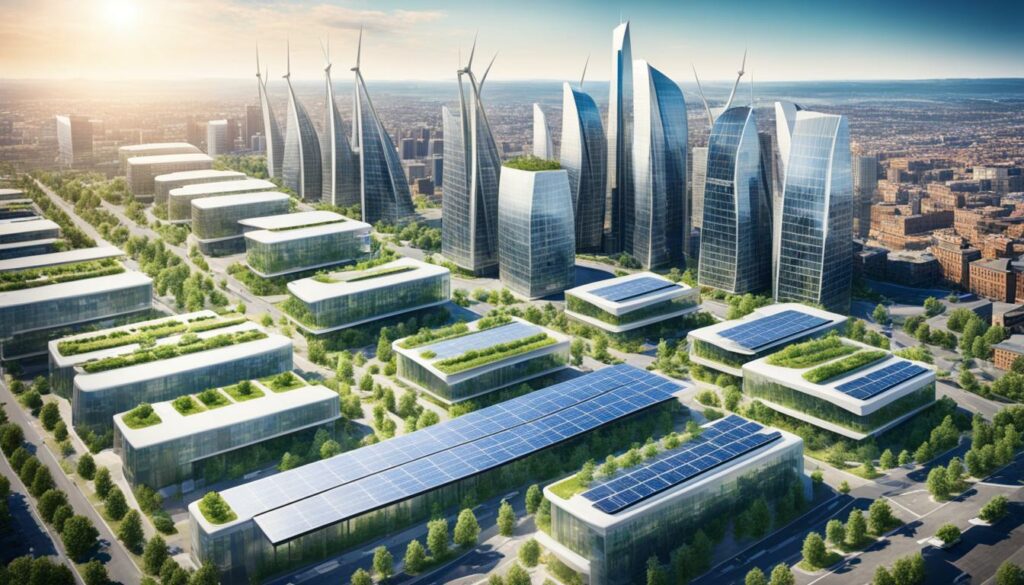
Cities like Burlington and Adelaide run entirely on renewable energy. They use biomass, hydro, wind, and solar power. These places show us that green urban development is possible with the right effort.
Worldwide, more than 830 cities aim to shift to renewable energy. Ten countries have started hydrogen plans by 2020. The European Commission wants to cut greenhouse gas emissions by 55% before 2030. These goals push cities to become greener.
Many big cities are making bold moves. Paris has stopped motorised vehicles in its core. Lower Saxony is swapping diesel trains for hydrogen ones. Both actions promote smart energy solutions and sustainability in city policies.
The World Economic Forum says smart energy needs to match city structures well. Putting up renewable energy locally can bring good changes for people and the planet. It shows how important local governments are in the green shift.
The COVID-19 outbreak has shown us we urgently need clean, strong energy in cities. Building more renewable energy in urban places will help us fight climate change. It will also make cities better prepared and stronger.
The sector of renewable energy is encountering big hurdles because of supply chain problems continuing. These hurdles are slowing down how fast renewable energy is growing, making things hard for the industry.
Material costs in renewable energy infrastructure are a big worry. For example, the prices of polysilicon, needed for solar panels, shot up by 350 percent from 2020 to June 2022. The wind industry saw prices jump two to three times for steel, copper, and aluminum because of the Ukraine crisis. These rising costs and material shortages are slowing the growth of many renewable energy projects.
Moreover, there’s a big lack of rare earth metals. By 2030, there might be a 50-60 percent shortage of metals like neodymium and praseodymium, which are key for wind and electric vehicles. To make things worse, 79 percent of the world’s polysilicon is made in China, with half in Xinjiang. This raises even more risks for those in wind and solar energy.
To lessen the supply chain issues, global teamwork and policy actions are key. McKinsey estimates that by 2030, electricity from solar and wind projects will increase from 125 to 459 gigawatts, not including China. But, to meet these goals, we must tackle the current problems.
The European Commission wants to increase Europe’s use of renewable electricity to 45 percent by 2030, up from 40 percent. But, this dream needs to beat many hard logistical, material, and trade challenges.
Handling the supply chain problems with strong plans is vital for renewable energy’s steady growth. Making logistics better, increasing how much we can install, and working together internationally are critical for a strong future in renewable energy.
The world is making big moves in renewable energy. Renewable energy trends show that onshore wind power has doubled by 2020 from 2019 levels. This growth is seen in both the past and future, with expectations of 6 million megawatts by 2050. This will require around 27 million tonnes of copper. Such progress is crucial for moving towards a greener energy future.
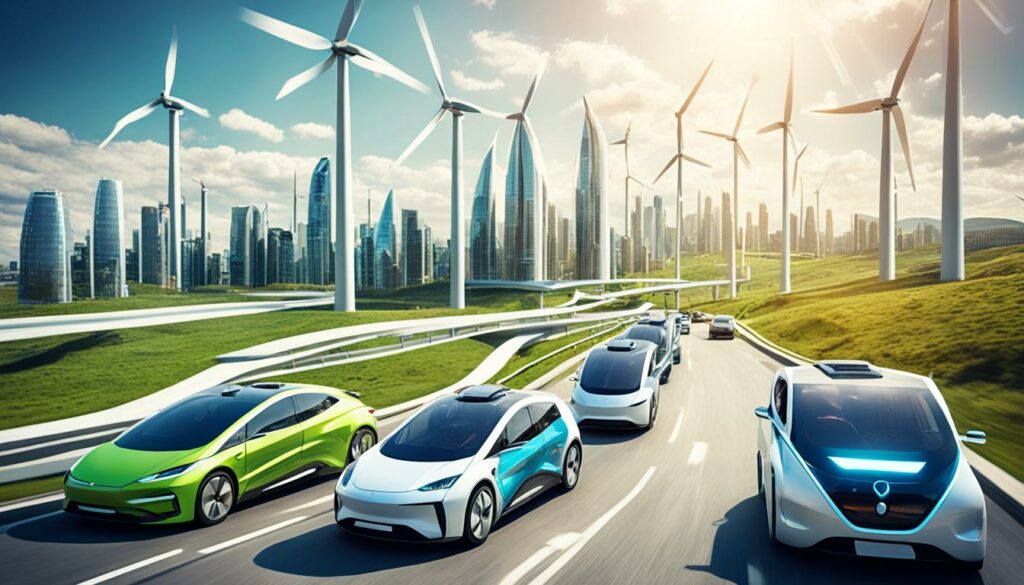
But, there are hurdles to cross. Solar panels and wind turbines could generate a lot of waste by 2050. To be exact, solar panels might create 78 million tonnes of waste, and wind turbines 43 million tonnes of blade waste. Additionally, by 2030, lithium-ion battery waste could hit 2 million tonnes per year. It’s clear that we need solid energy transition strategies to handle waste and reduce environmental harm. Especially as the need for minerals and metals skyrockets in the near future.
As we focus on meeting these needs, more steel, cement, aluminium, and plastics will be used. But, this increase will also add more CO2 to our atmosphere. For instance, making cement already contributes 2.2 billion tonnes of CO2 annually. This is about 8% of all global emissions. Yet, we can change this narrative. With smart planning, we can reuse land and cut down on harmful environmental effects. The US project “Site Wind Right” is a great example. It shows how we can balance erecting wind farms with protecting nature.
| Year | Metric | Projection |
|---|---|---|
| 2020 | Onshore Wind Capacity Increase | 2x 2019 levels |
| 2050 | Installed Wind Power Capacity | 6 million MW |
| 2050 | Solar Panel Waste | 78 million tonnes |
| 2030 | Lithium-ion Battery Waste Annually | 2 million tonnes |
| 2050 | Wind Turbine Blade Waste | 43 million tonnes |
To succeed, we must plan well and work together. IRENA teams up with many around the globe, especially in small islands and the poorest countries. The goal is to improve grids and create frameworks that can adapt. It’s this teamwork that will help us tackle the complex issues of moving to green energy. These collective energy transition strategies and funds are crucial. They help us build strong, eco-friendly energy networks for the future.
The renewable energy future in the United States is looking bright. This is thanks to the falling costs of wind and solar power. In the past decade, their prices have dropped significantly. Wind energy prices are down by 70%. Solar energy has seen an 89% decrease.
Now, wind and solar energy at a large scale are cheaper than gas or coal power. This sets a good stage for more progress in the future.
Forward-looking energy projections show big growth in renewable energy use. This will be helped by new rules that encourage using less energy. These rules reward companies that offer better service, making energy use more efficient.
Yet, state climate initiatives are also key to hitting national renewable energy targets. States can drive the country forward faster and better. To support more wind and solar power, the electricity grid needs to be updated. A smarter grid is vital to handle and spread renewable energy well.
To stay on a good path, smart policies are needed. Tax breaks from the government help a lot. They encourage renewable energy growth. Things like production tax credits and grants help new projects get started and grow.
As we shape an economy based on clean energy, we must be fair. Offering tax breaks for renewable projects in poorer areas or where old polluting plants have closed is crucial. This gives everyone a fair chance. It’s also important to protect the sea life around offshore wind farms. They should be managed carefully from start to finish.
Putting the right policies in place means the United States can lead in renewable energy. This brings long-term growth and helps protect the planet for future generations.
The future of renewable infrastructure is very important right now. After 18 years at the Bonneville Power Administration and building 15,000 miles of transmission, things are looking up. The work on storage and shaping services for wind energy shows a strong push for more renewable energy. The last seven years, with someone at the helm supporting wind, solar, and battery solutions, have been crucial.
Changes in how we store energy show how much we care about our planet. Most major utilities in the US are now working hard to be more eco-friendly. They want to make big cuts in harmful emissions. This follows a global call to greatly increase renewable power by 2030. The aim is to make cleaner, more efficient energy for the world.
But there are still big challenges. Even with national efforts, CO2 emissions are not dropping fast enough. Actions need to be taken now to really lower global CO2. By working together, those involved in making policy and in business, along with community members, can make a difference. The focus should be on using new ideas and practical steps to get over the challenges. This way, we can all enjoy a more sustainable and profitable energy future.
Renewable energy like solar and wind power leads new electricity generation. Support from laws like the Inflation Reduction Act is key. Yet, challenges from supply chain problems still slow things down.
The Inflation Reduction Act and the Bipartisan Infrastructure Law boost clean energy. These laws help with money and quicken the growth of renewable energy. But, getting permits and money can still be hard.
Big solar systems, better ways to store energy, and new wind tech are making renewable energy better. These innovations cut costs and make clean energy systems work more effectively.
Green energy networks are vital for keeping power reliable and clean. Upgraded power lines and systems help keep the lights on with green energy. This makes our power supplies more stable and better for the planet.
Local efforts focus on small renewable projects and green choices. Joining with businesses, schemes like NEVI aim to improve green power. They help make our move to clean energy smoother.
Plants that make green energy meet issues like slow supply chains and high costs. Delays and budget changes are common. These challenges can slow down green projects.
Clean energy leads to lower energy bills and new jobs. It boosts the economy through manufacturing and green projects. This means more money and growth for all of us.
Solar and wind power are growing fast. The U.S. added a lot of solar in 2023, showing more people prefer green energy. This trend is moving away from old fuel choices.
Big solar and wind farms are being built. The U.S. is also working on making clean energy better nationwide. These steps aim to increase how much green energy we use.
In cities, we’re adding smart ways to use energy and green tech. This includes more places to charge electric cars and adding green power to city grids. Cities are becoming greener with these efforts.
Not having enough materials can slow down green power projects. To fix this, we need smart plans that work worldwide. Making sure the parts we need get to where they’re needed is crucial for the future of renewable energy.
There’s a steady rise in green energy plans, driven by laws and new tech. Experts say we’ll install more renewable sources in the years to come. This is backed by strong policies for a cleaner future.